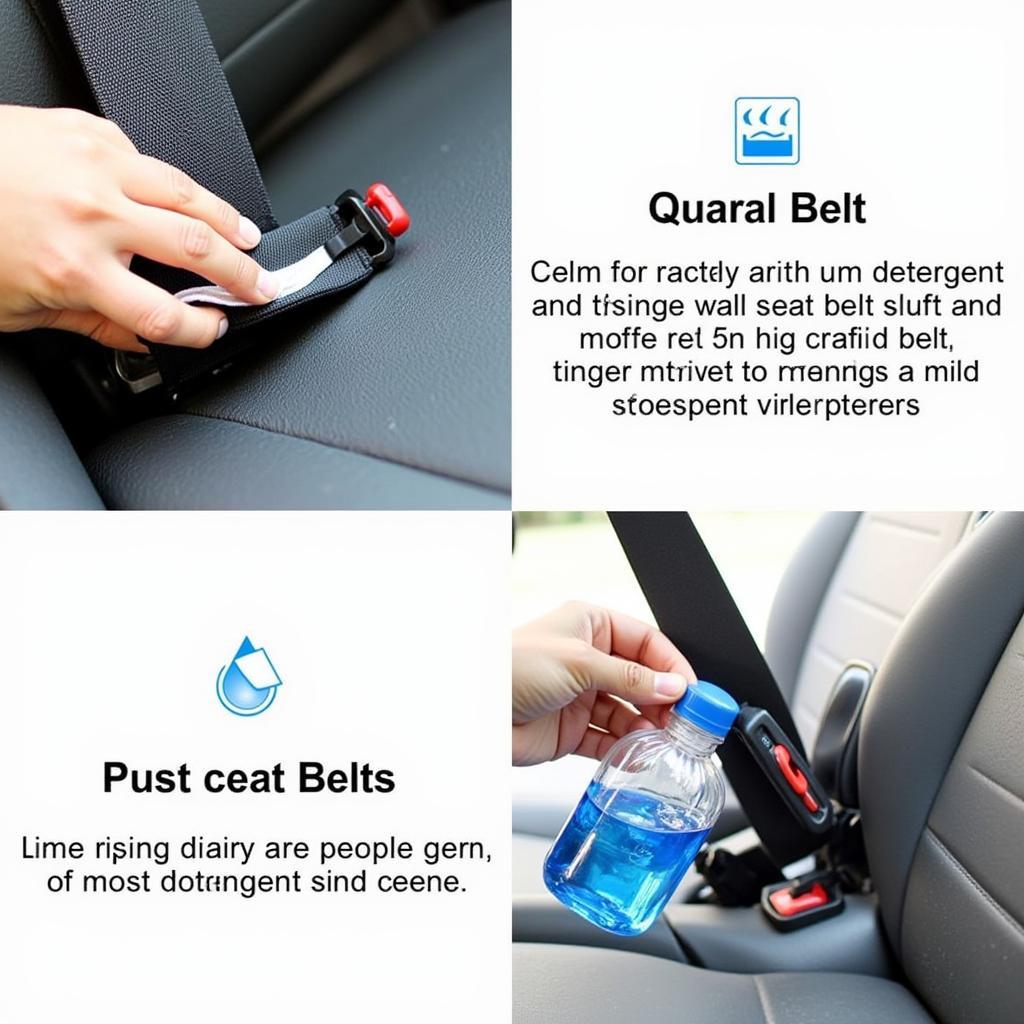A malfunctioning seat belt can be a serious safety hazard. Knowing How To Fix The Seat Belt Of A Car is crucial for ensuring your and your passengers’ protection. This comprehensive guide will cover the common seat belt issues, from a stuck retractor to a frayed belt, and provide step-by-step instructions on how to fix them.
Common Seat Belt Problems and Solutions
Seat belts, while durable, can encounter various problems. Here’s a breakdown of the most frequent issues and how to address them.
Seat Belt Retractor Issues
A slow or stuck retractor is a common problem. This often occurs due to dirt, dust, or twisted webbing.
- Inspect the retractor: Look for any visible obstructions like debris or twisted webbing near the retractor mechanism.
- Clean the retractor: Use a compressed air can to blow out dust and debris. You can also use a small brush to gently remove any stubborn dirt.
- Lubricate the retractor: Apply a small amount of silicone lubricant to the retractor mechanism. Be careful not to over-lubricate, as this can attract more dirt.
- Check the webbing: Ensure the seat belt webbing isn’t twisted or tangled. Straighten it out carefully.
Frayed Seat Belt Webbing
A frayed seat belt significantly reduces its effectiveness in a crash. If you notice any fraying, replacement is often the safest course of action.
- Assess the damage: Determine the extent of the fraying. Minor fraying can sometimes be temporarily repaired with specialized seat belt repair kits, but significant fraying warrants a complete replacement.
- Replace the seat belt: Consult your car’s owner’s manual or contact a qualified mechanic to replace the faulty seat belt. Never attempt to repair a severely frayed seat belt yourself.
Seat Belt Buckle Problems
A sticky or jammed buckle can prevent the seat belt from latching securely.
- Clean the buckle: Use a small brush and compressed air to remove dirt and debris from the buckle mechanism.
- Check for damage: Inspect the buckle for any cracks or broken parts. If you find any damage, the entire buckle assembly should be replaced.
- Lubricate the buckle: Apply a small amount of silicone lubricant to the moving parts of the buckle.
Seat Belt Pretensioner Issues
The pretensioner is a device that tightens the seat belt in a collision. If your pretensioner has deployed, it needs to be replaced by a professional.
- Do not attempt to repair: Tampering with a deployed pretensioner can be dangerous.
- Seek professional help: Contact a qualified mechanic to replace the deployed pretensioner and reset the system.
 Cleaning a Car Seat Belt Retractor
Cleaning a Car Seat Belt Retractor
Diagnosing Seat Belt Problems: A Step-by-Step Guide
Before attempting any repairs, it’s important to diagnose the specific problem.
- Visual Inspection: Carefully examine the entire seat belt assembly, from the buckle to the retractor and the webbing. Look for any signs of damage, wear, or blockage.
- Test the Retractor: Pull the seat belt out slowly and then let it retract. It should retract smoothly and completely.
- Check the Buckle: Fasten and unfasten the seat belt several times. The buckle should latch and release easily.
- Listen for Unusual Noises: Any grinding, clicking, or other unusual noises could indicate a problem with the retractor or buckle mechanism.
When to Seek Professional Help
While some seat belt issues can be addressed with simple DIY fixes, others require professional attention. If you encounter any of the following, it’s best to consult a qualified mechanic:
- Deployed pretensioners
- Severely frayed or torn webbing
- Damaged retractor mechanism
- Broken buckle components
- Any issue you are not comfortable addressing yourself
Preventative Maintenance for Your Seat Belts
Regular maintenance can help prevent seat belt problems and extend their lifespan.
- Regular Cleaning: Clean the seat belts periodically with a mild detergent and water.
- Inspection: Inspect the seat belts regularly for any signs of wear or damage.
- Avoid Harsh Chemicals: Don’t use harsh chemicals or cleaners on the seat belts, as these can damage the webbing.
 Performing Regular Seat Belt Maintenance
Performing Regular Seat Belt Maintenance
Conclusion
Knowing how to fix the seat belt of a car is essential for maintaining the safety of your vehicle. By understanding the common problems and following the provided solutions, you can address many issues yourself. However, always remember to prioritize safety and seek professional help when necessary. For any further assistance or inquiries, feel free to contact us at AutoTipPro. Our phone number is +1 (641) 206-8880 and our office is located at 500 N St Mary’s St, San Antonio, TX 78205, United States.
 Replacing a Damaged Car Seat Belt
Replacing a Damaged Car Seat Belt
Similar to the information provided in this article, more helpful tips for car maintenance can be found on our website about cost to fix wheel bearing on car north carolina.





Leave a Reply